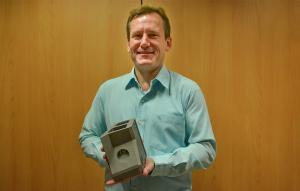Europe
3D printing for small-size components
8 Jan 2018
The European Domestic Agency is investigating the benefits of 3D printing for the fabrication of smaller size (up to metre-scale) metal components. The technique seems particularly well adapted to unconventionally shaped objects or those with complex interior geometry.
The European Domestic Agency's Stefan Wikman shows the result of his work with a Swedish consortium to examine the feasibility of 3D printing techniques to manufacture ITER components.
The new method, known as additive manufacturing, uses computer-aided design (CAD) drawings as a starting point to directly manufacture 3D objects in a more efficient and cost-effective approach that avoids the mockups and prototypes of traditional manufacturing. The 3D printing equipment is able to read CAD data and lay down successive layers of liquid, melted powder or sheet material to form the component—a process that may be particularly well suited to some of the highly complex components required for ITER.
Together with a Swedish consortium, the European Domestic Agency is studying the feasibility of different 3D printing techniques for the manufacturing of the first wall beam--a metal beam that will fix plasma-facing panels to each ITER blanket module. The component, made of ITER-grade stainless steel, has a very complex internal structure to accommodate the passage of cooling water pipes.
The first feasibility studies have shown that the first wall beam components produced this way meet ITER specifications for physical properties and mechanical stress tolerances. The next step is to apply this method to the fabrication of larger components.
The 3D printing techniques for stainless steel components developed as part of Europe's research and development for ITER open up spin-off opportunities for the manufacturing of complex unconventionally shaped components in other fields. Potential areas for application of the 3D manufacturing technology include power plants and car engines.
Read the full article on the European Domestic Agency website here.


